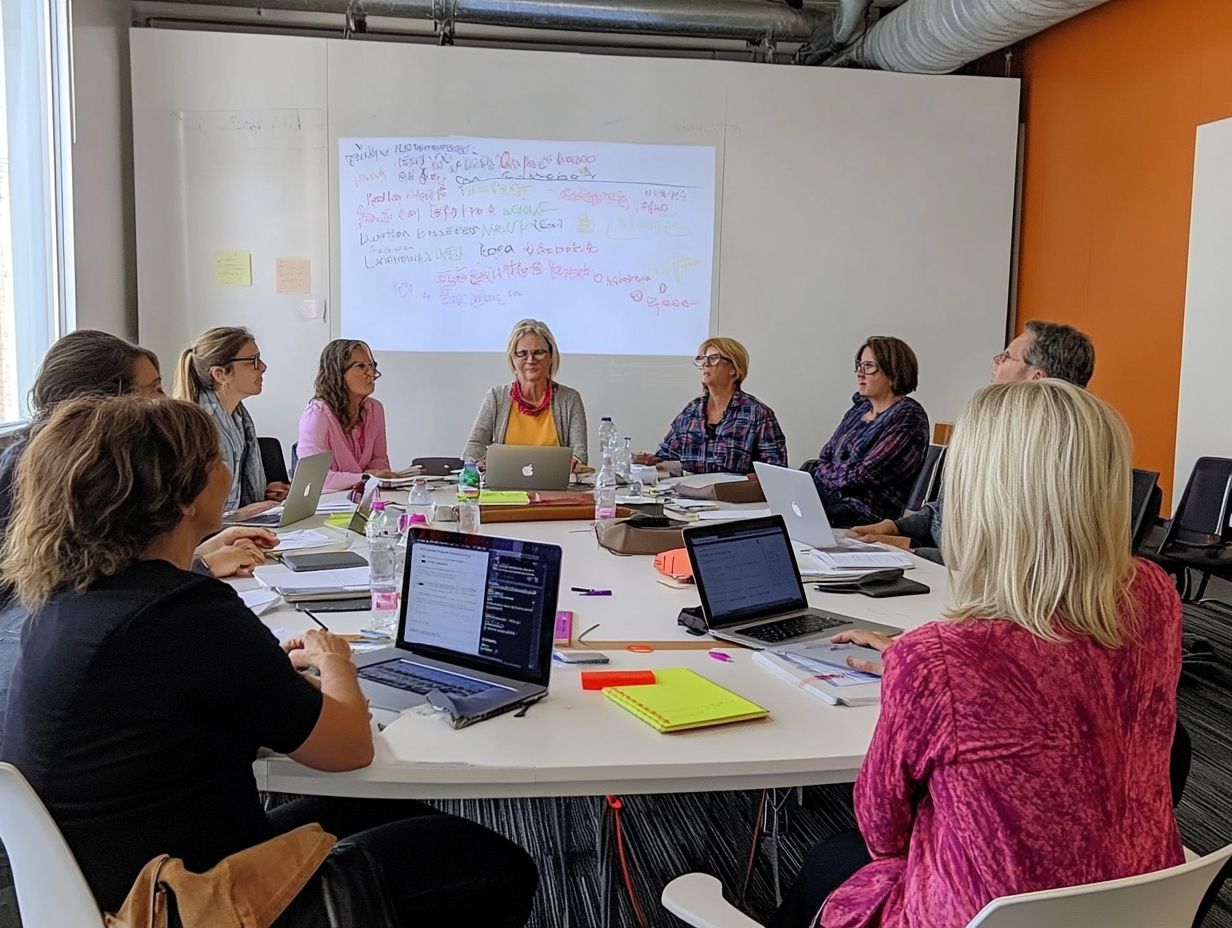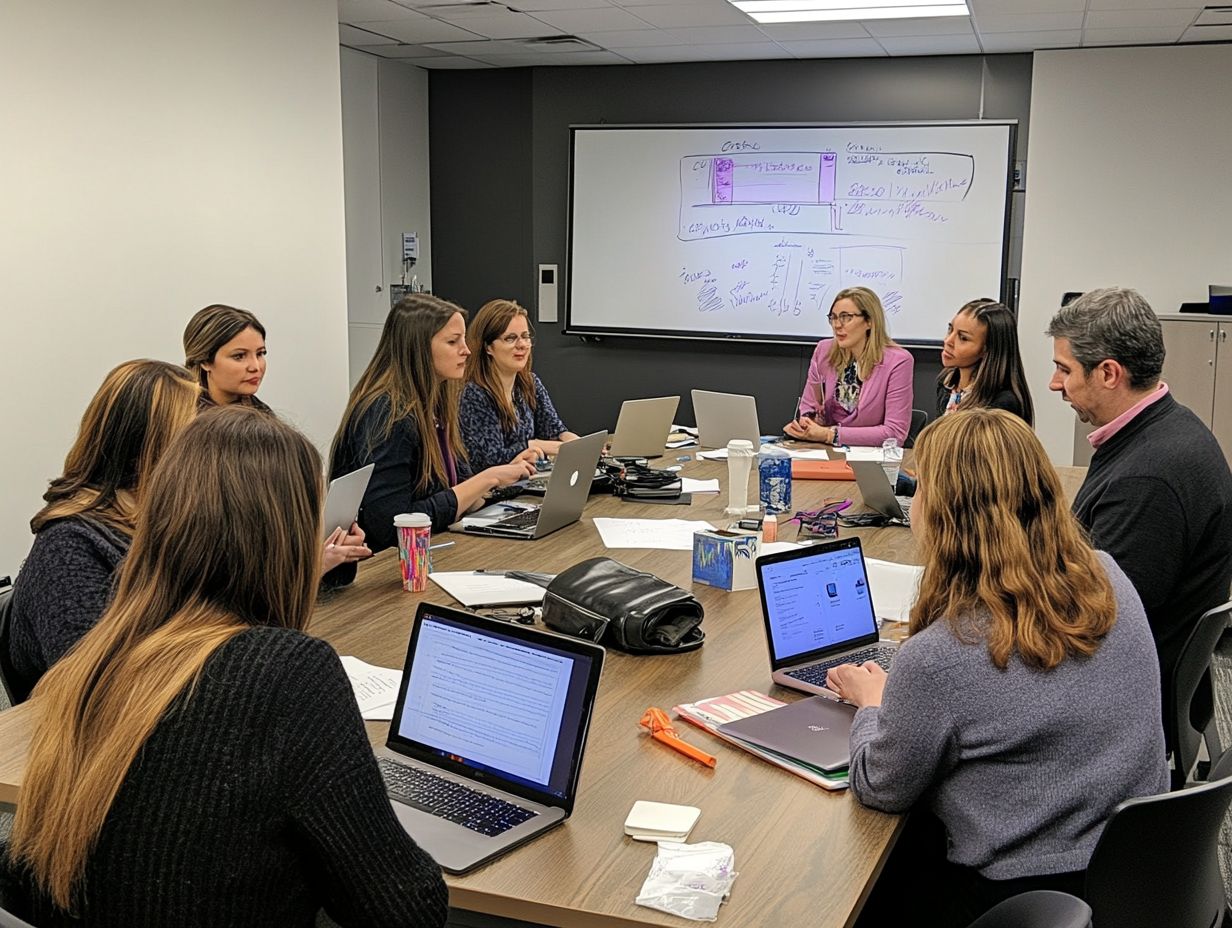Building a Leadership Development Culture
In today s fast-paced business landscape, cultivating a strong leadership development culture is crucial for your organization’s success.
This article delves into the importance of nurturing effective leaders within your organization, highlighting key elements such as defining leadership skills and creating growth opportunities.
You ll find insights on implementing a robust leadership development program, addressing common challenges, and measuring its success.
Embrace these strategies and cultivate a sustainable leadership pipeline that fosters innovation and engagement!
Continue reading to discover how you can transform your leadership development culture for lasting impact.
Contents
- Key Takeaways:
- The Importance of Leadership Development
- Key Elements of a Leadership Development Culture
- Implementing a Leadership Development Culture
- Measuring the Success of a Leadership Development Culture
- Frequently Asked Questions
- What is the importance of building a leadership development culture?
- How can an organization start building a leadership development culture?
- What are some key elements of a successful leadership development culture?
- Why Involve Employees in Leadership Development?
- Benefits of a Leadership Development Culture
- Challenges in Building a Leadership Development Culture
Key Takeaways:

- A leadership development culture is essential for the success of any organization, as it fosters strong leaders and promotes growth and development.
- Defining leadership skills, providing growth opportunities, and implementing mentorship programs are key elements of a successful leadership development culture.
- To implement a strong leadership development program, organizations should follow steps to build and overcome common challenges while continuously measuring and improving its success.
The Importance of Leadership Development
Leadership development is essential for nurturing effective leaders who can influence organizational culture and boost employee engagement. In today s competitive landscape, when you prioritize leadership development, you not only strengthen your leadership pipeline but also foster a culture that encourages accountability, innovative thinking, and teamwork.
Leadership skills are crucial for maneuvering through the complexities of modern business environments. They enable you to make informed decisions aligned with your organization s goals and values. Thus, investing in leadership development programs is not merely a strategic initiative; it s a fundamental element for ensuring long-term success and adaptability within your organization.
Why Every Organization Needs a Leadership Development Culture
A robust leadership development culture is crucial for any organization striving to excel in today’s ever-evolving market landscape, highlighting the importance of leadership development programs.
Such a culture not only creates a nurturing environment for emerging leaders but also actively enhances essential leadership qualities at every level. Companies like Intuit and Chick-fil-A Summit understand this well, implementing customized programs specifically designed to develop vital skills and align individual ambitions with the organization’s mission.
Take Intuit, for example. Their emphasis on mentorship and continuous learning enables employees at all stages to step into leadership roles, significantly enhancing their engagement and productivity. Similarly, Chick-fil-A Summit champions servant leadership principles in its training programs, cultivating leaders who prioritize team engagement and customer satisfaction.
Ultimately, this synergy between personal growth and organizational goals elevates performance management initiatives to new heights.
Key Elements of a Leadership Development Culture
Creating a leadership development culture requires focus on several key elements. First, you need to define clear leadership skills, provide growth opportunities, and consider creating inclusive leadership development programs while engaging in ongoing cultural assessments.
Prioritizing training programs that enhance crucial leadership skills like emotional intelligence, adaptability, and strategic thinking is essential, as these attributes significantly bolster the effectiveness of leaders. By crafting a framework for continuous learning and improvement, you enable your leaders and cultivate a resilient leadership pipeline, one that s well-equipped to navigate both present and future challenges.
Defining Skills Leaders Need
Defining skills leaders need is a crucial first step in cultivating a strong leadership training culture within your organization. This approach not only establishes clear expectations for emerging leaders but also matches their growth with your organization’s goals.
In today s fast-paced environment, you must cultivate key competencies, particularly in decision-making. This skill enables you to analyze complex situations and arrive at sound conclusions, a necessity for effective leadership.
Honing your communication skills is also essential for fostering collaboration and ensuring that your messages resonate across diverse teams.
Emotional intelligence stands out as another vital competency, enabling you to navigate interpersonal dynamics and build strong relationships.
By implementing targeted training programs, you can systematically assess and nurture these abilities, ensuring that you and your fellow leaders are well-equipped to tackle the challenges of today s world.
Creating Opportunities for Growth and Development

Create opportunities for growth. This enhances your leadership capacity and encourages ongoing learning.
You can achieve this through various strategies that not only align with your organization s goals but also cater to the individual aspirations of your team members.
Experiential learning plays a crucial role, allowing employees to tackle real-world challenges that sharpen their problem-solving skills.
On-the-job training reinforces this commitment, equipping your team with the essential skills they need as they navigate their daily tasks.
By implementing innovative training methods, such as mentorship programs and online learning platforms, you can establish customizable growth paths that resonate with both personal and organizational objectives, ultimately elevating the entire workforce.
Establishing Mentorship and Coaching Programs
Establishing mentorship and coaching programs is essential for cultivating a strong leadership training culture. These frameworks not only provide valuable guidance but also create an environment where emerging leaders can sharpen their skills through constructive feedback.
Implementing structured mentorship opportunities helps organizations enable experienced leaders to share their insights and experiences, significantly enhancing the learning curve for junior members.
Effective coaching serves as a bridge, connecting theoretical knowledge with practical application, ensuring that you develop vital leadership skills.
Strong feedback processes within these programs encourage open communication, fostering both personal and professional growth. This builds a network of relationships that can further enrich your developmental journey.
Implementing a Leadership Development Culture
Implementing a leadership development culture requires a thoughtful, systematic approach that seamlessly integrates leadership training strategies, performance management systems, and cultural assessments. This focus on creating a culture of skill development makes accountability and effectiveness real goals.
Steps to Building a Strong Leadership Development Program
Building a strong leadership development program demands a strategic approach that blends training initiatives with essential leadership skills, including how to cultivate a growth mindset in leaders.
To effectively design such a program, begin by identifying the specific skills that resonate with your organizational goals.
This ensures that participants not only acquire vital skills but also comprehend their real-world applications.
Recognizing the importance of emotional intelligence is paramount; leaders who can empathize with their teams cultivate a collaborative environment.
Integrating ongoing feedback processes paves the way for continuous improvement, enabling leaders to adapt through constructive criticism and success stories.
For example, implementing 360-degree feedback mechanisms allows individuals to gather diverse perspectives on their leadership style, ultimately refining their approach and elevating overall team performance.
Overcoming Common Challenges
Overcoming common challenges in leadership development requires you to be adaptable. Implement effective recognition systems.
Many organizations face difficulties in identifying capable leaders and nurturing their skills. This often occurs due to a lack of structured programs and clear pathways for growth. This situation can lead to frustration among aspiring leaders who may feel overlooked.
To tackle these challenges, cultivate an environment where accountability takes center stage. Establish clear expectations. Consistently provide constructive feedback to help leaders own their development journey.
Offer various growth opportunities. Mentorship programs and cross-departmental projects nurture talent and enhance the organization s resilience.
Measuring the Success of a Leadership Development Culture

Measuring how well your leadership development culture works is key! It drives continuous improvement and keeps your organization adaptable. By tracking progress and assessing outcomes, you can address common challenges in leadership development to create an environment that nurtures leadership skills while driving the organization toward excellence and innovation.
Key Metrics to Track
Tracking key metrics is essential for assessing the impact of leadership development initiatives on employee engagement and leadership effectiveness.
Evaluate specific factors such as employee retention rates and performance appraisal results. Gather comprehensive feedback from all sides to uncover valuable insights into how these programs affect overall success. These metrics highlight areas for improvement and establish accountability within your leadership framework.
Linking these insights to growth opportunities allows for better alignment with your organizational goals. This cultivates a culture of continuous learning, ultimately enhancing both individual and team performance.
Continuous Improvement and Adaptation
Continuous improvement and adaptation are vital for you to maintain a dynamic leadership development culture that responds effectively to your organization’s changing needs. To achieve this, consider exploring how to evaluate leadership development programs.
Integrate regular feedback processes. This cultivates an environment where emerging leaders feel valued and are encouraged to share their insights.
This approach strengthens relationships and informs the evolution of your training strategies. Ensure they align with current challenges and future aspirations.
Embracing a culture of ongoing learning allows you to swiftly adjust leadership approaches. Individuals are equipped with the necessary skills to navigate complex, ever-shifting landscapes. Act now to build a resilient leadership pipeline that thrives on adaptability and responsiveness.
Frequently Asked Questions
What is the importance of building a leadership development culture?
A leadership development culture helps organizations nurture future leaders, spark growth, and drive success!
How can an organization start building a leadership development culture?

An organization can start building a leadership development culture by identifying potential leaders. To enhance this process, it’s vital to offer the future of leadership development through training and development opportunities, and create a supportive and collaborative work environment.
What are some key elements of a successful leadership development culture?
Key elements include a clear leadership development strategy, effective communication, continuous learning and feedback, and a commitment to diversity and inclusion.
Why Involve Employees in Leadership Development?
Involving employees boosts engagement and motivation. This ownership fosters their professional growth.
Benefits of a Leadership Development Culture
Such a culture offers individuals personal and professional growth opportunities. It also helps organizations cultivate capable leaders who drive success.
Challenges in Building a Leadership Development Culture
Building this culture can face challenges like resistance to change or lack of resources. You can tackle these issues with a strategic approach.






